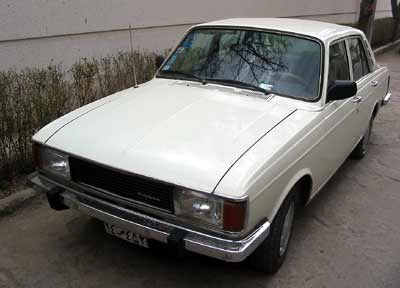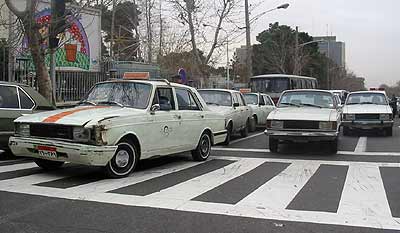TRAVELS IN THE AXLES OF EVIL -- IN PRAISE OF THE PAYKAN

Breathing in a lungful of Tehran air is a full-frontal assault on the respiratory system.
Your eyes sting. Your nose burns. Your lungs tighten.
A thick petrochemical smog hangs over this city of 12 million people for much of the year, bathing it in a purply-grey haze. At times the pollution is so bad it blocks the view of the Alborz mountains to the north, where wealthy Tehranis escape to ski and take a break from the chronic overcrowding.
A taxi ride through Tehran can often seem like an afternoon jaunt on the frontline of a war zone.
Cars hurtle in every direction, coughing out exhaust fumes and squeezing through the most impossibly tight gaps in the traffic. Drivers pull out from curbs at wild angles, forcing motorists to swerve suddenly to avoid a collision.
Trying to follow another vehicle through Tehran’s streets is almost impossible because the majority of them are identical. Some 70% of cars on the capital’s roads are battered, white(ish) Paykans.
The Paykan, Iran’s equivalent to the East German Trabant, will look familiar to many British eyes. It’s a locally-made version of the Hillman Hunter, a box-like sedan manufactured in the UK during the 1960s and 1970s.
The Paykan (the word means “arrow” in Farsi) was the first car to be manufactured in Iran, in 1967. Two models were sold at first – the “standard” and the ambitiously named “deluxe.” The range soon expanded to include a Paykan taxi, pick-up and even an automatic model.

Production of the Hillman Hunter ended in Britain in 1979 – but its Iranian brother survived.
Millions of them have rolled off the production line at the state-owned Khodro car plant west of Tehran, providing several generations of Iranians with an affordable, if not particularly luxurious mode of transport.
Pre-revolutionary models are said to be particularly sturdy and surprisingly feisty.
Like workhorse car marques the world over – Skoda, Lada and of course Trabant – the Paykan is the butt of countless jokes. Telling an Iranian friend who’s looking for you in a swarm of traffic that “I’m the one in the white Paykan” is sure to raise a smile. You and every other motorist in Iran, they’ll reply.
Yet the ubiquity of the Paykan has benefits.
Replacement parts are easy to find and any mechanic in Iran can strip one down with his eyes closed.

It seems, however, that the Paykan’s days are finally numbered.
Khodro is looking to the future and has ambitious plans to team up with international manufacturers to build luxury cars. The ancient Paykan is no longer part of its long term strategy.
It is being gradually phased out and the final one will roll of the production line some time after 2005.
However the Paykan’s attractive combination of affordability and reliability means it’ll be many years yet before this unlikely object of Iranian national pride and affection finally disappears from Iran’s streets.

Breathing in a lungful of Tehran air is a full-frontal assault on the respiratory system.
Your eyes sting. Your nose burns. Your lungs tighten.
A thick petrochemical smog hangs over this city of 12 million people for much of the year, bathing it in a purply-grey haze. At times the pollution is so bad it blocks the view of the Alborz mountains to the north, where wealthy Tehranis escape to ski and take a break from the chronic overcrowding.
A taxi ride through Tehran can often seem like an afternoon jaunt on the frontline of a war zone.
Cars hurtle in every direction, coughing out exhaust fumes and squeezing through the most impossibly tight gaps in the traffic. Drivers pull out from curbs at wild angles, forcing motorists to swerve suddenly to avoid a collision.
Trying to follow another vehicle through Tehran’s streets is almost impossible because the majority of them are identical. Some 70% of cars on the capital’s roads are battered, white(ish) Paykans.
The Paykan, Iran’s equivalent to the East German Trabant, will look familiar to many British eyes. It’s a locally-made version of the Hillman Hunter, a box-like sedan manufactured in the UK during the 1960s and 1970s.
The Paykan (the word means “arrow” in Farsi) was the first car to be manufactured in Iran, in 1967. Two models were sold at first – the “standard” and the ambitiously named “deluxe.” The range soon expanded to include a Paykan taxi, pick-up and even an automatic model.

Production of the Hillman Hunter ended in Britain in 1979 – but its Iranian brother survived.
Millions of them have rolled off the production line at the state-owned Khodro car plant west of Tehran, providing several generations of Iranians with an affordable, if not particularly luxurious mode of transport.
Pre-revolutionary models are said to be particularly sturdy and surprisingly feisty.
Like workhorse car marques the world over – Skoda, Lada and of course Trabant – the Paykan is the butt of countless jokes. Telling an Iranian friend who’s looking for you in a swarm of traffic that “I’m the one in the white Paykan” is sure to raise a smile. You and every other motorist in Iran, they’ll reply.
Yet the ubiquity of the Paykan has benefits.
Replacement parts are easy to find and any mechanic in Iran can strip one down with his eyes closed.

It seems, however, that the Paykan’s days are finally numbered.
Khodro is looking to the future and has ambitious plans to team up with international manufacturers to build luxury cars. The ancient Paykan is no longer part of its long term strategy.
It is being gradually phased out and the final one will roll of the production line some time after 2005.
However the Paykan’s attractive combination of affordability and reliability means it’ll be many years yet before this unlikely object of Iranian national pride and affection finally disappears from Iran’s streets.

0 Comments:
Post a Comment
<< Home